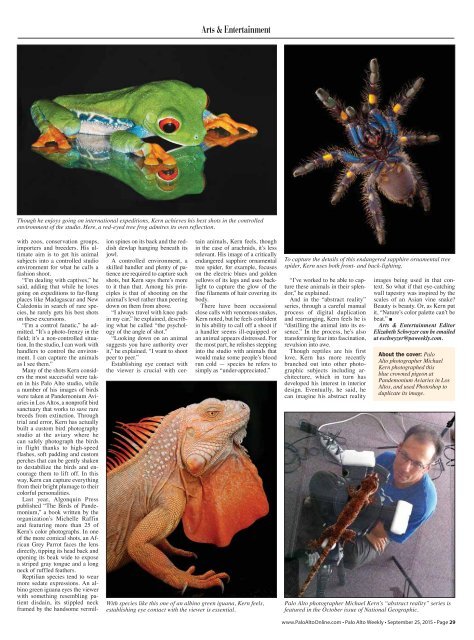Create successful ePaper yourself
Turn your PDF publications into a flip-book with our unique Google optimized e-Paper software.
Arts & Entertainment<br />
Though he enjoys going on international expeditions, Kern achieves his best shots in the controlled<br />
environment of the studio. Here, a red-eyed tree frog admires its own reflection.<br />
with zoos, conservation groups,<br />
importers and breeders. His ultimate<br />
aim is to get his animal<br />
subjects into a controlled studio<br />
environment for what he calls a<br />
fashion shoot.<br />
“I’m dealing with captives,” he<br />
said, adding that while he loves<br />
going on expeditions to far-flung<br />
places like Madagascar and New<br />
Caledonia in search of rare species,<br />
he rarely gets his best shots<br />
on these excursions.<br />
“I’m a control fanatic,” he admitted.<br />
“It’s a photo-frenzy in the<br />
field; it’s a non-controlled situation.<br />
In the studio, I can work with<br />
handlers to control the environment.<br />
I can capture the animals<br />
as I see them.”<br />
Many of the shots Kern considers<br />
the most successful were taken<br />
in his Palo Alto studio, while<br />
a number of his images of birds<br />
were taken at Pandemonium Aviaries<br />
in Los Altos, a nonprofit bird<br />
sanctuary that works to save rare<br />
breeds from extinction. Through<br />
trial and error, Kern has actually<br />
built a custom bird photography<br />
studio at the aviary where he<br />
can safely photograph the birds<br />
in flight thanks to high-speed<br />
flashes, soft padding and custom<br />
perches that can be gently shaken<br />
to destabilize the birds and encourage<br />
them to lift off. In this<br />
way, Kern can capture everything<br />
from their bright plumage to their<br />
colorful personalities.<br />
Last year, Algonquin Press<br />
published “The Birds of Pandemonium,”<br />
a book written by the<br />
organization’s Michelle Raffin<br />
and featuring more than 25 of<br />
Kern’s color photographs. In one<br />
of the more comical shots, an African<br />
Grey Parrot faces the lens<br />
directly, tipping its head back and<br />
opening its beak wide to expose<br />
a striped gray tongue and a long<br />
neck of ruffled feathers.<br />
Reptilian species tend to wear<br />
more sedate expressions. An albino<br />
green iguana eyes the viewer<br />
with something resembling patient<br />
disdain, its stippled neck<br />
framed by the handsome vermilion<br />
spines on its back and the reddish<br />
dewlap hanging beneath its<br />
jowl.<br />
A controlled environment, a<br />
skilled handler and plenty of patience<br />
are required to capture such<br />
shots, but Kern says there’s more<br />
to it than that. Among his principles<br />
is that of shooting on the<br />
animal’s level rather than peering<br />
down on them from above.<br />
“I always travel with knee pads<br />
in my car,” he explained, describing<br />
what he called “the psychology<br />
of the angle of shot.”<br />
“Looking down on an animal<br />
suggests you have authority over<br />
it,” he explained. “I want to shoot<br />
peer to peer.”<br />
Establishing eye contact with<br />
the viewer is crucial with certain<br />
animals, Kern feels, though<br />
in the case of arachnids, it’s less<br />
relevant. His image of a critically<br />
endangered sapphire ornamental<br />
tree spider, for example, focuses<br />
on the electric blues and golden<br />
yellows of its legs and uses backlight<br />
to capture the glow of the<br />
fine filaments of hair covering its<br />
body.<br />
There have been occasional<br />
close calls with venomous snakes,<br />
Kern noted, but he feels confident<br />
in his ability to call off a shoot if<br />
a handler seems ill-equipped or<br />
an animal appears distressed. For<br />
the most part, he relishes stepping<br />
into the studio with animals that<br />
would make some people’s blood<br />
run cold — species he refers to<br />
simply as “under-appreciated.”<br />
With species like this one of an albino green iguana, Kern feels,<br />
establishing eye contact with the viewer is essential.<br />
To capture the details of this endangered sapphire ornamental tree<br />
spider, Kern uses both front- and back-lighting.<br />
“I’ve worked to be able to capture<br />
these animals in their splendor,”<br />
he explained.<br />
And in the “abstract reality”<br />
series, through a careful manual<br />
process of digital duplication<br />
and rearranging, Kern feels he is<br />
“distilling the animal into its essence.”<br />
In the process, he’s also<br />
transforming fear into fascination,<br />
revulsion into awe.<br />
Though reptiles are his first<br />
love, Kern has more recently<br />
branched out into other photographic<br />
subjects including architecture,<br />
which in turn has<br />
developed his interest in interior<br />
design. Eventually, he said, he<br />
can imagine his abstract reality<br />
images being used in that context.<br />
So what if that eye-catching<br />
wall tapestry was inspired by the<br />
scales of an Asian vine snake?<br />
Beauty is beauty. Or, as Kern put<br />
it, “Nature’s color palette can’t be<br />
beat.” <br />
Arts & Entertainment Editor<br />
Elizabeth Schwyzer can be emailed<br />
at eschwyzer@paweekly.com.<br />
About the cover: Palo<br />
Alto photographer Michael<br />
Kern photographed this<br />
blue crowned pigeon at<br />
Pandemonium Aviaries in Los<br />
Altos, and used Photoshop to<br />
duplicate its image.<br />
Palo Alto photographer Michael Kern’s “abstract reality” series is<br />
featured in the October issue of National Geographic.<br />
www.PaloAltoOnline.com • Palo Alto Weekly • September 25, 2015 • Page 29


